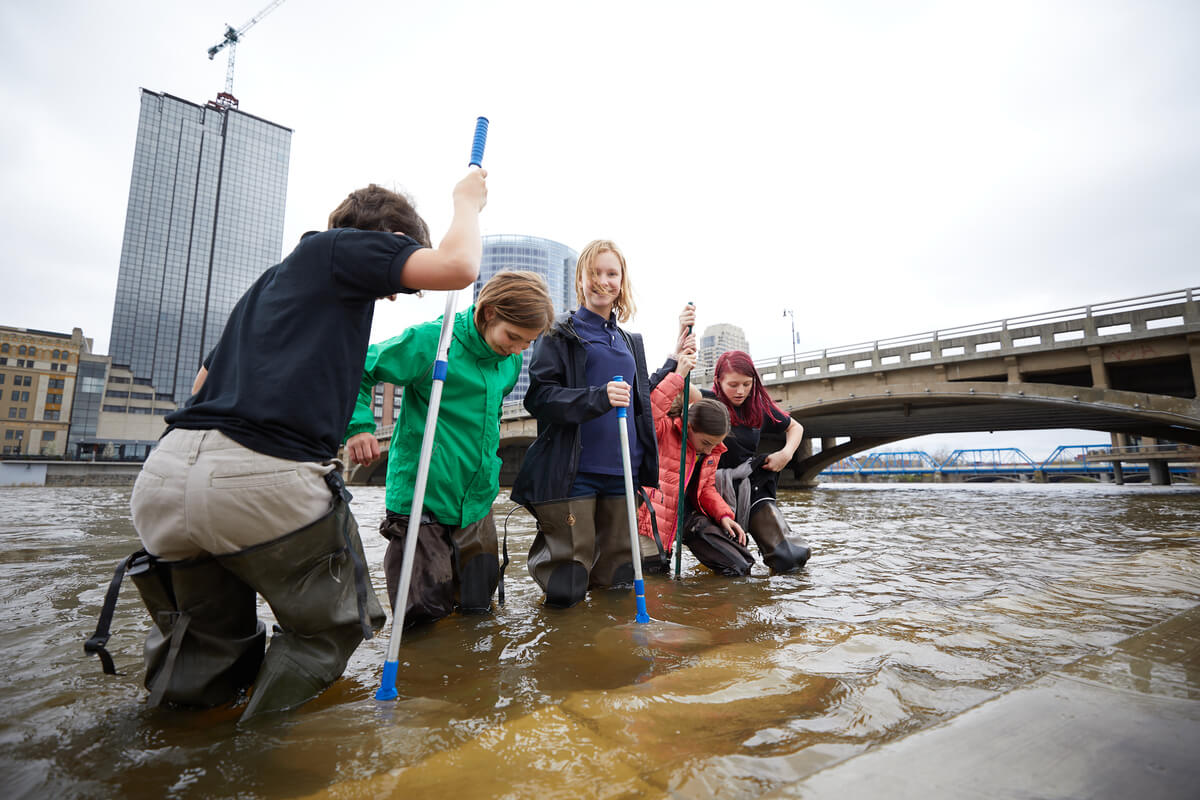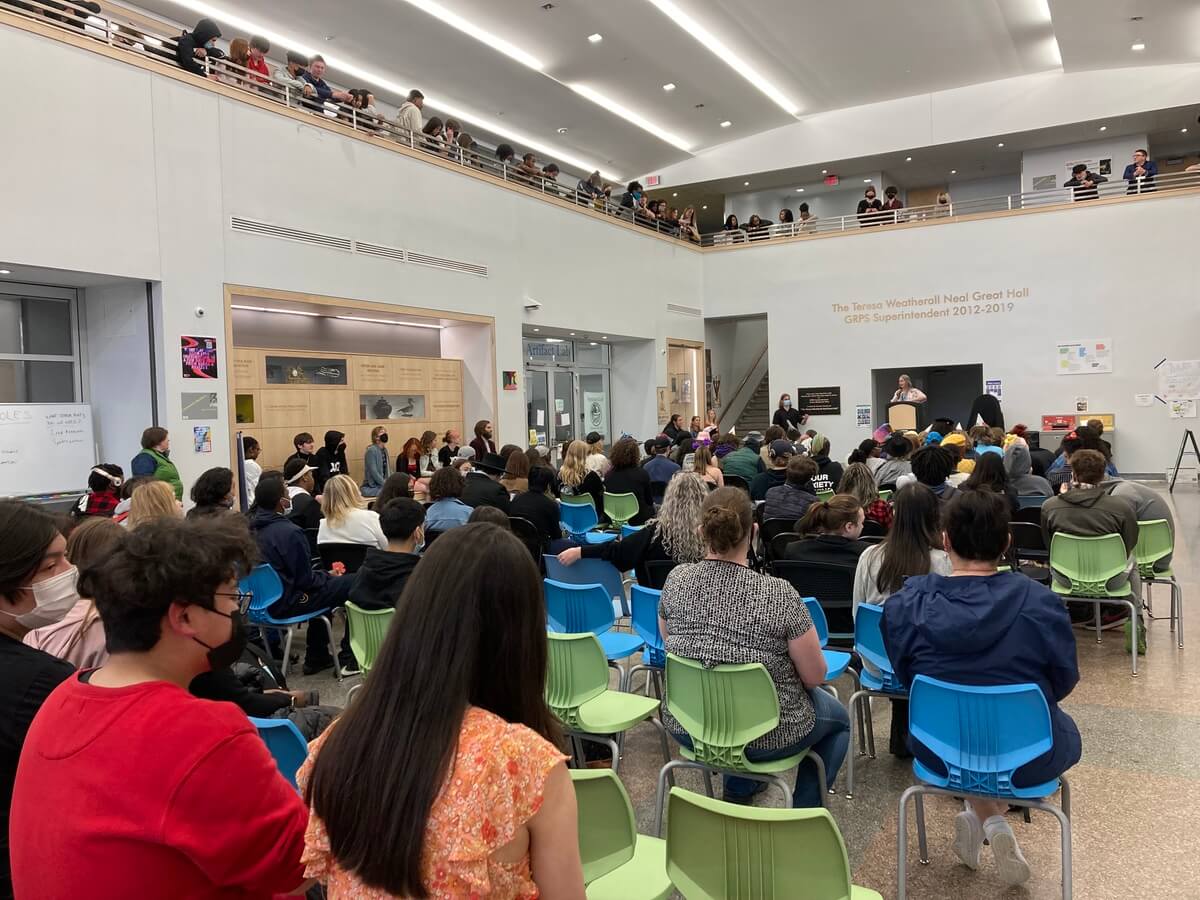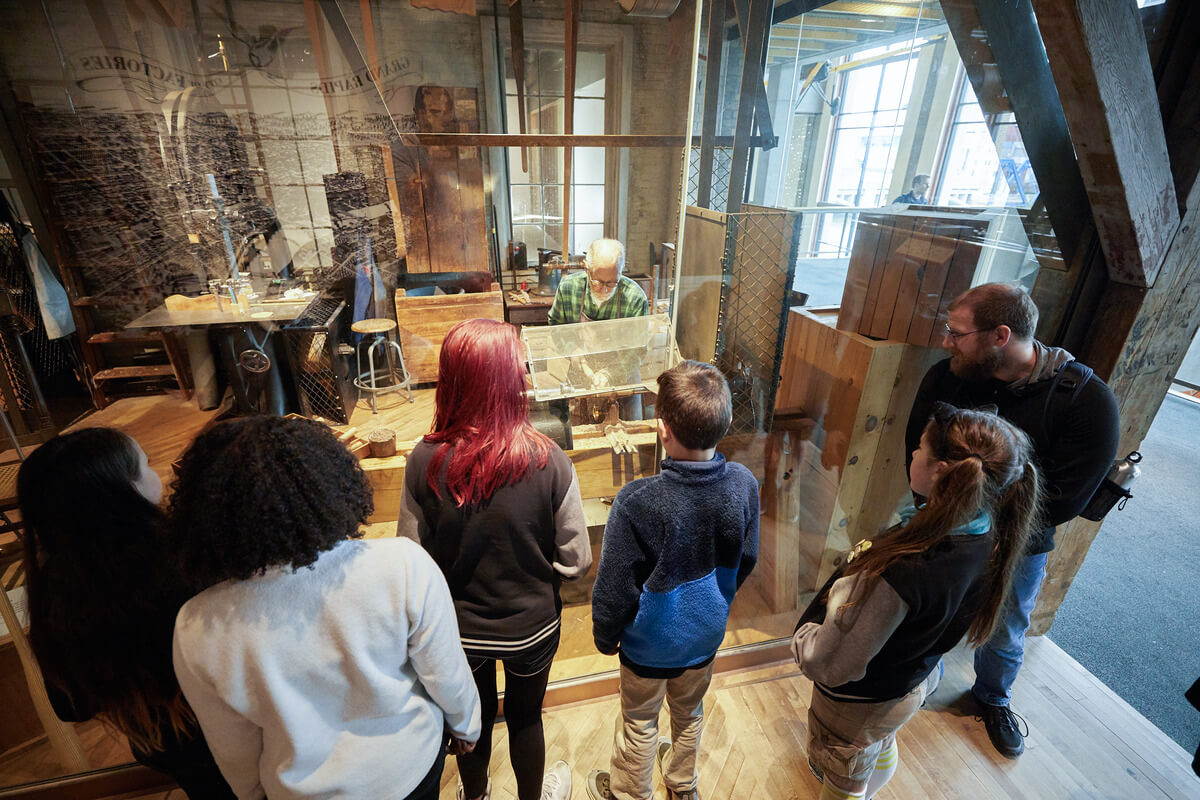Michigan Teens, Schooled in an Old Museum Without Classrooms, Eclipse Status Quo
Grand Rapids Public Museum School bucks all traditional school facility expectations and embeds students in the community for project-based learning.

This article was published in partnership with The 74 and originally published on that site.
Eleventh grader Genesis Villafane has two words to describe her Michigan high school: “harmonious pandemonium.”
At the Grand Rapids Public Museum School in the Grand Rapids Public Schools district, Genesis and her peers experience a constant juxtaposition of creativity and commotion because of their school’s non-traditional approach of embedding students — literally — in the community, and injecting the community into learning.
“In one corner, you had Mr. [Nate] Langel doing a science lesson, and across the room, the choir group was practicing next to seniors working on their community project,” she explained. “Every day it’s like this.”
Community projects are a defining feature of how students learn at GRPMS, an approach facilitated by the school’s physical space. The high school opened downtown in 2018 in the museum’s current archives building, and former location, after being selected as an XQ Super School. Students have access to 250,000 archives they can use as primary sources.
As just one example of the school’s community-based lessons, Genesis’s English class partnered with a local nonprofit restorative arts group, The Diatribe, on the south side of the city.
“They helped us write pieces of art related to issues that matter to us and our community,” she said, noting how this collaboration helped her learn about issues like gentrification and redlining. Genesis said the project also made her feel more connected to revitalization efforts across Grand Rapids — efforts similar to those that helped bring her innovative high school to life.
Many schools may visit a local institution or use projects for part of the year in a few classes. But GRPMS uses this dual approach in all of its classes, year-round, because of its commitment to XQ’s Design Principles, which include meaningful, engaged learning. Research shows that when educators incorporate real-world, interdisciplinary learning experiences into their practice, students develop and apply deep content knowledge and complex skills.
[[Read more about how to design engaging projects at your school in The XQ Xtra — a newsletter for educators that comes out twice a month. Sign up here.]]
The graduation rate for the Michigan high school’s first cohort in 2022 was above 86%, five percentage points higher than that of the surrounding district and state. More than two-thirds of GRPMS class of 2022 graduates (67%) met the SAT’s college-ready benchmark for evidence-based reading and writing in 2021, far outpacing both the state and district rates (57% percent and 40%, respectively).
The small district high school of about 300 students is still new. But with a survey finding most U.S. high school students were feeling bored and stressed even before the pandemic, GRMPS is already yielding lessons for other schools trying to bring a more engaging approach to secondary education that’s also preparing them better for collaboration and critical thinking skills students need today in college and careers.
Collaborate with a District
The Museum High School, as it’s known by the community, was developed through an ongoing, multiyear collaboration between the Grand Rapids public school district, Grand Valley State University, Kendall College of Art and Design and the City of Grand Rapids. A middle school opened in 2015 in the Grand Rapids Public Museum’s current location and its founders wanted to build on its success by developing a high school.
“For our model, we wanted to use the whole city as our classroom,” said Christopher Hanks, founding and current principal for both the middle and high school. Hanks saw the high school as a model for teaching and learning centered on both place-based and project-based learning.
But getting different players in a school district to come together requires relationship building. A former professor of education at Grand Valley State, Hanks iterated on the school’s design with colleagues from higher education, the museum and the district. Many of the founders who helped design the school serve on its advisory board and remain committed to its mission and culture. The school also offers dual enrollment at local colleges, and more than half of its 2022 graduates earned college credits, higher than the national average and something it holds in common with other XQ high schools.
Take Learning Outside the Classroom
The logistics of even one field trip — transportation, staffing and emergency planning — can burden many schools and districts. To avoid these obstacles altogether, Hanks worked with the Grand Rapids district to make field trips part of the high school’s design.
“We landed on a two-mile contingency radius,” he said. That agreement ensured the school had immediate access to dozens of potential partners students could connect with in downtown Grand Rapids, including the YMCA and the library, so leaving the campus isn’t a hassle.

Given that the high school is located in the museum’s former building, it lacks hallways and traditional classrooms. But Hanks and the teachers embraced another XQ design principle — smart use of time, space and technology. A wide-open hall on the ground floor, the Commons, is a flexible space where student learning is curated and put on display.
“There’s a lot of convergence that happens in this space,” Hanks explained. “Students and teachers will gather here to learn, connect on projects, as well as bring in the community for student-focused events.”
Empower Teachers and Provide Support
With the school’s location and its extensive network of community partners, teachers at GRPMS say they feel empowered to create innovative and authentic learning experiences that are meaningful to students.
Project-based learning drives core classes. With this innovative curriculum, social studies teacher Lindsay Lane said she has the ability to teach history in a more expansive way.
“We blend the humanities with the sciences, but we also show students how events like the Industrial Revolution occurred around the world,” she explained. “How the science and technology impacted the U.S., and how that shaped the story of Grand Rapids.”
Science teacher Langel described how in one project he designed, teachers connected numerous standards between science and history by having students partner with a local organization that addresses homelessness.
“It was about what goes together,” he said. “Students learning how to make soap for the unhoused were able to connect biochemistry standards with the concepts of human rights.”
The school also discovered it needed more planning time as it developed competency-based education, a system that relies on more than just letter grades to show what students are learning. CBE is often viewed as simply an assessment system instead of a deeper shift in learning. Hanks said the school had to completely “blow-up the grading system,” rethinking what pacing, evaluation and student learning demonstrations look like. Teachers now get professional development over the summer to support and enhance consistency.

Troubleshoot with Leadership Support
While these projects in the core classes have been successful, teachers struggled to fit math into their multi-disciplinary design. That difficulty was reflected in the school’s math scores, which weren’t nearly as strong as they were in other subjects.
Ben Garlets, a former GRPMS math teacher, said many high schools across the country experience a similar challenge when trying to include math in project-based learning. He said GRPMS faced two specific challenges: scheduling the math that needs to be taught over the course of a year into projects, and keeping students at the same grade level together when they’re at different levels of mathematical proficiency.
Garlets devised a solution: making math more like the other nontraditional classes, not less.
“It didn’t make sense to do traditional mathematics if we were rethinking everything else,” he explained. That meant letting students see math’s relevance without forcing it into projects or tying it to other core subjects.
Garlets determined that an integrated mathematics curriculum would be a strong fit. He presented it to Hanks as a departure from the traditional “algebra-geometry sandwich,” in which the different mathematical concepts are isolated from one another, and students may struggle to see the relevance between them.
Hanks helped him figure out how to get this curriculum approved by district leaders and connected him to the principal of the museum’s middle school, who had experience with the approach. When it comes to innovation, Hanks said “no” is never the first answer. Instead, he said he works with the district to understand what its policies and limitations are so they can find a middle ground.
Garlets, who is now working for the Grand Rapids district, said that type of leadership style is essential for an innovative school, which needs a strong mission and culture, another XQ design principle, to make lasting and meaningful changes.
“We were really empowered by Hanks to rethink what we’re doing in our classrooms.”
Keep Evolving
Five years into its journey, the high school is still learning what works best. As Hanks explained, a school’s vision must be earned and re-earned, learned and re-learned every year. GRPMS keeps that same lesson in mind when it comes to the greater community.
“We’ve learned how to test the institutional relationships with our partners as we’ve evolved to ensure people remain committed,” Hanks said.
Consistency helps, too. Science teacher Langel is among many staff who have been with GRPMS from the start.
“Just as a museum becomes a place for the community to learn about itself, the school really brings it out for students, and they connect with that,” he said.
According to the Grand Rapids school district’s strategic plan, theme schools like GRPMS are highly valued by residents because they offer choice, innovative curricula and greater access to community partnerships. But GRPMS stands out because its enrollment is more diverse and representative of the city overall. The district sees that as a source of inspiration. GRPMS and its partners expect more participants in this year’s summer institute for educators who want to learn from and replicate the school’s successful approaches.
[[Do you want to learn more about how to rethink high school? The XQ Xtra is a newsletter for educators that comes out twice a month. Sign up here.]]
Edward Montalvo is the senior education writer at The XQ Institute. He was previously Dean of Students at PSI High in Sanford, Florida.









